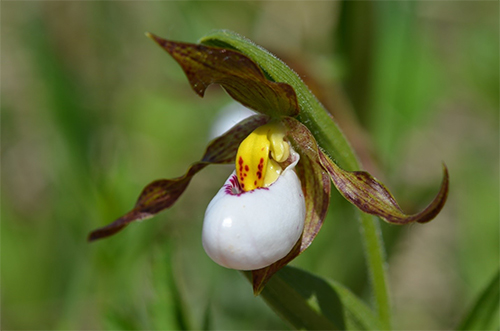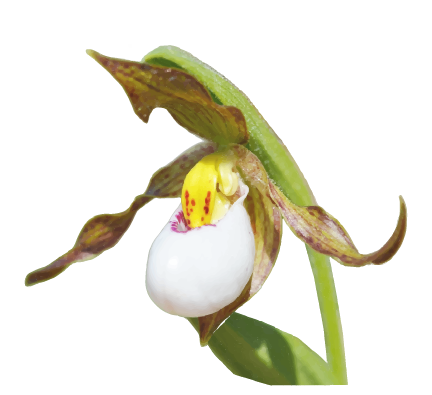Small White Lady’s-slipper

Species information
The following is a report on progress made towards the protection and recovery of Small White Lady’s-slipper (Cypripedium candidum) in Ontario from 2007 to 2020, based on Ontario’s species-specific recovery policy. This report meets the legislative requirement for a review of progress under the Endangered Species Act, 2007 (ESA or “the Act”). Small White Lady’s-slipper is listed as endangered on the Species at Risk in Ontario (SARO) List under the ESA.
Small White Lady’s-slipper has been classified as a species at risk since 1999. It was originally classified as an endangered species and was listed under the ESA when it came into force in June 2008.
Small White Lady’s-slipper has been protected from being killed, harmed, harassed, captured or taken since 2008.
In addition, the habitat of Small White Lady’s-slipper has been protected from being damaged or destroyed since 2013.
The species-specific recovery policy for Small White Lady’s-slipper, known as the Government Response Statement (GRS), was published in 2016 and includes the government’s recovery goal for the species and the actions and priorities it intends to lead or support to help achieve that goal. The GRS considers science advice provided in the recovery strategy, when developing recovery actions for the species. As legislated in the Act, the purpose of this review is to report on progress made towards implementing the protection and recovery actions in the GRS. The review can also help identify opportunities to adjust and adapt the implementation of protection and recovery actions to achieve the recovery goal for the species.
Further information about Small White Lady’s-slipper, including the threats that it faces, and actions being taken to help protect and recover this species is available on the Government of Ontario webpage for Small White Lady’s-slipper. A summary on the progress towards the protection and recovery of Small White Lady’s-slipper and an annual update on the broader species at risk program (i.e. the Introduction to the 2021 Review of Progress report) is available on the Review of Progress towards the Protection and Recovery of Ontario’s Species at Risk webpage.
Snapshot: Progress towards the protection and recovery of Small White Lady’s-slipper
Progress towards meeting the recovery goal
- The recovery goal in the Government Response Statement (GRS) for Small White Lady’s-slipper in Ontario is to “maintain the distribution of Small White Lady’s-slipper in Ontario and support natural increases in abundance at existing locations”.
- Progress has been made towards implementing all of the government-led actions. Progress has been made towards implementing all of the government-supported recovery objectives and a majority of the associated actions. Examples of progress include:
- development of a standardized survey protocol for Small White Lady’s-slipper
- research and guidelines to better inform prescribed burning of prairie habitats, including guidelines specific to Bkejwanong (Walpole Island First Nation)
- education and outreach on species at risk that are found in prairie habitats, including the Small White Lady’s-slipper
- In alignment with the GRS, more work is required to conduct studies to better understand the ecology, threats and habitat requirements of Small White Lady’s-slipper, determine the effectiveness and risks of habitat management practices on this species, and implement and evaluate existing habitat management plans through collaborative efforts between Bkejwanong, land owners and managers, and local organizations. Work is also needed to increase awareness of the significance, uniqueness and vulnerability of this plant species.
Occurrences and distribution
- Small White Lady’s-slipper is found in isolated populations
footnote 1 in Hastings County in southeastern Ontario and Bkejwanong on the delta of the St. Clair River in southwestern Ontario. - The Natural Heritage Information Centre (NHIC) has received nearly 225 records of Small White Lady’s-slipper based on observations made between 1903 and 2018. No new populations of Small White Lady’s-slipper have been identified since 2008.
- The potential range
footnote 2 of the species is approximately 10 square kilometres based on recent observations, with an additional 22 square kilometres of historical habitat.
Government-supported stewardship projects:
- Through the Species at Risk Stewardship Program, the Government of Ontario has enabled its stewardship partners to conduct 13 projects (by providing $548,133 in funding) that have supported the protection and recovery of Small White Lady’s-slipper. One project focused exclusively on Small White Lady’s-slipper, while the other 12 projects focused on multiple species at risk, including Small White Lady’s-slipper.
- The government’s support helped its stewardship partners to involve 784 individuals who volunteered 14,386 hours of their time towards protection and recovery activities for species at risk, including Small White Lady’s-slipper. The estimated value of these voluntary contributions, as well as additional funding and in-kind support, is at least $1,086,938.
- Stewardship partners reported that through their actions 0.4 hectares of habitat were enhanced for Small White Lady’s-slipper and other species at risk that inhabit the same ecosystem.
- Stewardship partners reported providing outreach on multiple species at risk, including Small White Lady’s-slipper, to 554 individuals.
- Through the Species at Risk Research Fund for Ontario, the Government of Ontario supported one research partner to conduct research on a remote method of detecting wind and insect pollinated plant populations.
Supporting human activities while ensuring appropriate support for species recovery
- Eight activities have been registered for the species. The activities were registered under ‘Notice of drainage works’ (section 23.9) and ‘Threats to health and safety, not imminent’ (section 23.18) under Ontario Regulation 242/08 of the ESA.
Reporting on the progress towards the protection and recovery of Small White Lady’s-slipper
Recovery goal
The government’s goal for the recovery of Small White Lady’s-slipper is to maintain the distribution of Small White Lady’s-slipper in Ontario and support natural increases in abundance at existing locations.
The implementation of government-led and government-supported actions demonstrates progress towards reaching the desired objectives and the recovery goal set out in the GRS.
Progress towards implementing government-led actions
Progress has been made towards implementing all government-led actions identified in the GRS. Common actions for the government to lead as it works towards achieving a species’ recovery goal include:
- Co-operate with federal partners, such as Environment and Climate Change Canada, to implement protection and recovery actions, where appropriate.
- Educate other agencies and authorities involved in planning and environmental assessment processes on the protection requirements under the ESA.
- Encourage the submission of Small White Lady’s-slipper data to the Ministry’s central repository at the Natural Heritage Information Centre (NHIC).
- Undertake communications and outreach to increase public awareness of species at risk in Ontario.
- Protect Small White Lady’s-slipper and its habitat through the ESA.
- Develop direction to provide greater clarity to proponents and partners on the areas of general habitat protected under the ESA for plant species at risk.
- Support conservation, agency, municipal and industry partners, and Indigenous communities and organizations to undertake activities to protect and recover Small White Lady’s-slipper. Support will be provided where appropriate through funding, agreements, permits (including conditions) and/or advisory services.
- Encourage collaboration, and establish and communicate annual priority actions for government support in order to reduce duplication of efforts.
Additionally, the government has directly undertaken the following species-specific actions:
- Continue to implement the Ontario Invasive Species Strategic Plan to address the invasive species (e.g., Phragmites) that threaten Small White Lady’s-slipper.
Key progress made towards implementing these actions is described in the following sections.
Ontario’s Invasive Species Act
The GRS for Small White Lady’s-slipper indicates that invasive species (e.g. Phragmites) pose a threat to the survival and recovery of the species in Ontario. The Ontario Invasive Species Strategic Plan, 2012 and the Invasive Species Act, 2015 provide the policy and legislative framework to prevent new invaders from arriving and surviving in Ontario; to slow and where possible reverse the spread of existing invasive species, and to reduce the harmful impacts of existing invasive species, including impacts on species at risk. This framework may support the implementation of actions to reduce the threats from invasive species.
Occurrences and distribution
Small White Lady’s-slipper is found in isolated populations
For this review of progress, the species’ occurrence information has been assessed at a landscape scale using one by one kilometre grid “squares” to approximate the species’ distribution. The squares were used to estimate where the species has been recently observed (i.e., has been observed within the past 20 years) as well as squares where the species is considered historical
Using this approach, the species has been recently observed in 10 squares, and there are 22 additional squares with historical observations of the species. This equates to a potential range of approximately 10 square kilometres based on recent observations of the species, and an additional 22 square kilometres based on historical observations. Additionally, there are four observation records from more than 50 years ago in areas that have had no more recent observations. However, since these four records do not have precise data on the location and size of the populations observed, it is difficult to estimate the extent of habitat that existed at that time.
Since 2008, the government’s central repository at the NHIC has received nearly 225 records of the species. These records are based on observations between 1903 and 2018 and come from a variety of sources. All observations since 2008 have been associated with Small White Lady’s-slipper plants from Hastings County.
It is possible that there are observations of Small White Lady’s-slipper that have not been submitted to the government. Encouraging the submission of observations of this species is included in the GRS as a government-led action and may be required by an authorization or approval. Submission of species observations increases our knowledge of where they occur and can play an important role in assessing the viability of species populations. Observations may now be submitted to NHIC via the Rare Species of Ontario project in iNaturalist
-
190observations of this species were submitted to the NHIC since 2008
Government-supported stewardship projects
An important government-led action in the GRS for Small White Lady’s-slipper is to support partners to undertake activities to protect and recover the species. Through the Species at Risk Stewardship Program the government has supported 13 projects ($548,133) designed to contribute to the protection and recovery of Small White Lady’s-slipper. One of these projects focused exclusively on the species, while the other 12 projects focused on multiple species at risk, including Small White Lady’s-slipper. In addition to the government funding, partners focusing exclusively on Small White Lady’s-slipper reported they were successful in securing additional funding from other sources, as did partners with projects designed to benefit multiple species at risk, including Small White Lady’s-slipper, for a total of $ 1,086,938 additional funding secured. This amount includes in-kind support in the form of time and expertise provided by volunteers.
Stewardship partners reported that provincial funding helped them to secure in-kind support by involving 784 individuals who volunteered 14,386 hours of their time towards protection and recovery activities for multiple species at risk, including Small White Lady’s-slipper, which has an estimated value of $415,701. Partners also reported that through both their efforts and the efforts of their volunteers to implement GRS, they were successful in enhancing 0.4 hectares of habitat that will benefit multiple species at risk, including Small White Lady’s-slipper. In addition, stewardship partners reported providing ecosystem-based outreach on multiple species, including Small White Lady’s-slipper, to 554 individuals.
The government also supports proponents in conducting research that addresses important knowledge gaps for species at risk. Through the Species at Risk Research Fund for Ontario, the government provided funding to a partner to conduct research on a remote method of detecting wind and insect pollinated plant populations, which could help to detect populations of Small White Lady’s-slipper.
The remainder of this section highlights two projects supported through the Species at Risk Stewardship Program as well as the corresponding government-supported recovery actions for the species.
In 2020, the Standardized Survey Protocol for Small White Lady’s-slipper (Cypripedium candidum) was developed by North-South Environmental Inc., with input from biologists, ecologists, and other experts from Manitoba and Ontario. The document includes a wealth of information about Small White Lady’s-slipper, including its identification, distribution, ecology, and threats, provides an overview of past survey methods, identifies recommended areas to search for the species in Ontario, and lays out a science-based, standardized survey protocol. Using a standardized survey protocol ensures reliable and consistent data collection and reporting of various measures such as population size, threats, and site condition. This can help to address knowledge gaps related to the species’ abundance, habitat quality and threats, to better inform management actions.
This document emphasizes that only experienced, qualified and careful individuals should conduct occasional surveys for Small White Lady-slipper, as the species and its habitat are extremely sensitive to disturbance (e.g. surveying once every five years, on average is recommended). It is also important to report the results of all surveys to the NHIC, even if Small White Lady’s-slipper is not found, and to keep locations of Small White Lady’s-slippers confidential to prevent trampling and illegal removal. This project directly supports the implementation of the government-supported GRS action to develop and implement a standardized protocol for surveying and monitoring Small White Lady’s-slipper (Action No. 1 – High Priority).
Between 2007 and 2008, the Walpole Island Heritage Centre developed several documents to guide protection and recovery efforts for species at risk, including Small White Lady’s-slipper, on Walpole Island. These included a species at risk curriculum for elementary school students, a youth stewardship program plan, a species at risk communications and outreach strategy, and a plan and guidelines for prescribed burning on Bkejwanong (Walpole Island First Nation). Traditional Knowledge was weaved into each of these materials. This supports the implementation of the government-supported GRS actions to record, share and transfer traditional knowledge (Action No. 2) and increase awareness of Small White Lady’s-slipper (Action No. 6).
Species at Risk Stewardship Program
-
 13
13projects included White Lady's-slipper
-
 1
1project for White Lady's-slipper exclusively
-
 $548,133
$548,133for projects that included White Lady's-slipper
-
 $1,086,938
$1,086,938in additional funding and in-kind support
-
 784
784volunteers
-
 14,386
14,386volunteer hours
-
 554
554people received outreach
-
 0.4
0.4hectares of habitat enhanced
Supporting human activities while ensuring appropriate support for species recovery
Supporting partners through authorizations and their associated conditions is an important government-led action. To date, no permits have been issued for Small White Lady’s-slipper.
Eight activities that may affect Small White Lady’s-slipper or its habitat have been registered for the purposes of Ontario Regulation 242/08 under the ESA. Four activities were registered under ‘Notice of drainage works’ (sectio 23.9), and four activities were registered under ‘Threats to health and safety, not imminent’ (section 23.18). These registrations require the registrant to comply with all conditions of the regulation, such as:
- preparing a mitigation plan by one or more persons with expertise in relation to the Small White Lady’s-slipper, using the best available information on steps that may help minimize or avoid adverse effects on the species
- ensuring that reasonable steps are taken to minimize adverse effects of the activity on the species (e.g. installing and maintaining barriers or other structures to create a protective zone around the species)
- reporting observations of the species using the Ontario Species at Risk Observation Reporting Form and submitting it to the NHIC
-
8registrations
Progress towards implementing government-supported actions
Government-supported actions are organized under overarching recovery objectives. Progress has been made towards achieving all government-supported recovery objectives and implementing a majority of the associated actions identified in the GRS for Small White Lady’s-slipper.
Objective: Increase knowledge of the species’ abundance and better understand the quality of the habitat and treats at each location to inform approaches to habitat management.
- Action No. 1 (High Priority) – Develop and implement a standardized protocol for surveying and monitoring Small White Lady’s-slipper in order to:
- document population abundance, extent of occurrence, demographic changes, reproductive success, habitat conditions, hydrological conditions, and the severity of threats to the species at existing locations
- determine the status of populations for which the current status is unknown
- Action No. 2 – Work collaboratively with Indigenous communities and organizations to record, share and transfer Traditional Ecological Knowledge on Small White Lady’s-slipper as available, including information on the historical distribution of the species and conditions of its habitat (e.g., the historical frequency of wildfire within the species' habitat). Use information gathered to inform survey protocols and habitat management actions and coordinate collaborative knowledge transfer with efforts for other species at risk plants which occur in the same ecosystems.
Under this objective, considerable progress has been made towards implementing Action No. 1, while progress has been made towards Action No. 2.
Considerable progress has been made towards implementing Action No. 1 through several projects supported by the Species at Risk Stewardship Program. A standardized survey protocol for Small White Lady’s-slipper (described above) has been developed. Another project updated maps for tallgrass habitat in southern Ontario, which may contribute to surveying and monitoring efforts for this species. A third project tested a remote detection method for rare plants, while another project undertook inventory work for multiple species at risk in areas where Small White Lady’s-slipper may be found.
Action No. 2 has been implemented through three projects supported by the Species at Risk Stewardship Program including the Walpole Island Heritage Centre work described above, and others that included building Traditional Ecological Knowledge into species at risk education and recovery initiatives.
Objective: Increase knowledge of the species' ecology and effective threat management practices to inform development of survey protocols and habitat management plans.
- Action No. 4 – Conduct studies that increase knowledge of:
- the species' ecology, including its reproductive biology, population dynamics, and habitat requirements
- threats to the species (e.g., hybridization and invasive species)
- the effectiveness and risks of habitat management practices (e.g., vegetation management techniques) used to manage habitat for the species
Under this objective, initial progress has been made towards implementing Action No. 4. Progress towards this action has occurred through the development of a Best Management Practices document prepared by the Ontario Invasive Plant Council that addresses the impact of invasive Phragmites control measures on species at risk, including Small White Lady’s-slipper. This action has also been implemented through a literature review on the ecology and threats to several dozen orchid species in Ontario, including Small White Lady’s-slipper, and investigations into fire behaviour to support tall-grass prairie management. These projects were supported by the Species at Risk Stewardship Program.
Objective: Work collaboratively to maintain or improve the quality of the habitat for Small White Lady’s-slipper at existing locations.
- Action No. 5 (High Priority) – Work collaboratively with Bkejwanong (Walpole Island First Nation) community members and other interested Indigenous communities and organizations, land owners and land managers to develop, implement and evaluate management plans to maintain or improve the quality of habitat available for Small White Lady’s-slipper at each of the existing populations. Plans may include practices deemed to be effective and appropriate, such as:
- changes to mowing, haying and livestock grazing practices
- removal of invasive plants (e.g., Phragmites) and woody vegetation (e.g., Eastern White Cedar) posing a direct threat to Small White Lady’s-slipper in a manner that does not adversely affect Small White Lady’s-slipper
- prescribed burning (as appropriate)
- redirecting recreational activities away from the species
- supporting existing community-based stewardship and land conservation initiatives that further the protection of Small White Lady’s-slipper
Under this objective, initial progress has been made towards implementing Action No. 5. With support from the Species at Risk Stewardship Program, three collaborative projects were undertaken to develop plans and provide recommendations related to prairie habitat management. One of these projects researched fire behaviour in tallgrass prairie habitats and provided recommendations on prescribed burning to local landowners based on their findings. The second project by Bkejwanong developed a species at risk communications strategy, prescribed burn guidelines, and youth species at risk stewardship program in collaboration with community members. Finally, the development of a Best Management Practices document for invasive Phragmites (described above) with input from numerous experts, organizations and land managers also supports the implementation of this action.
Objective: Increase awareness about the significance, uniqueness and vulnerability of Small White Lady’s-slipper.
- Action No. 6 – Without disclosing locations of orchids, provide information to orchid enthusiasts, recreational trail users, and other stakeholder regarding the risks to Small White Lady’s-slipper from collecting and inadvertent trampling.
Under this objective, initial progress has been made towards implementing Action No. 6. Projects supported through the Species at Risk Stewardship Program developed communications material that identified threats to the species, and provided education to students and the general public on Small White Lady’s-slipper and other species at risk, including those associated with tallgrass prairies and rare orchids.
Summary of progress towards meeting the recovery goal
The recovery goal for Small White Lady’s-slipper is “to maintain the distribution of Small White Lady’s-slipper in Ontario and support natural increases in abundance at existing locations”. Effort made towards the government-led and government-supported actions has helped to make progress towards this goal. For example, through support from the Species at Risk Stewardship Program, a standardized survey protocol has been developed to determine and monitor the status of Small White Lady’s-slipper populations, and several outreach and education initiatives have informed southern Ontario communities about species at risk that depend on prairie habitats, such as Small White Lady’s-slipper. The stewardship program has also supported research on prescribed burns and the development of prescribed burn guidelines for Bkejwanong, which may help maintain or improve Small White Lady’s-slipper habitat. Traditional Ecological Knowledge of the species and its habitat was frequently incorporated into these projects.
The provincial record of observations indicate that Small White Lady’s-slipper continues to persist in Ontario.
Recommendations
As stated in the GRS, this review of progress can be used to help identify whether adjustments to the implementation of GRS actions are needed, to achieve the protection and recovery of the species. Based on progress to date, the overall direction provided in the GRS for Small White Lady’s-slipper, particularly the implementation of actions identified as high priority, should continue to guide protection and recovery of the species.
Although initial progress has been made towards the action to increase knowledge of the species' ecology and effective threat management practices (Action No. 4), further work is required to fully implement this action. This includes studies on the species’ ecology and threats, and how different threat management practices impact the Small White Lady’s-slipper.
Additional work is also needed to collaborate to maintain or improve the quality of the habitat for the Small White Lady’s-slipper (Action No. 5 – High Priority) by implementing and evaluating existing habitat plans and recommendations. Increasing awareness about the significance, uniqueness and vulnerability of Small White Lady’s-slipper (Action No. 6) is needed as well, since outreach efforts have been largely multi-species and/or habitat-focused.
Relative to actions that have received a stronger level of support, the following action has received less attention and is identified for consideration in future work towards the protection and recovery of the species:
- Action No. 3 - Conduct hydrological studies to better understand the habitat conditions required by Small White Lady’s-slipper and investigate the effects of potential alterations to the hydrologic regime that may be occurring at sites where the species has been found in Ontario.
Protecting and recovering Small White Lady’s-slipper will continue to be a shared responsibility that will require the involvement of many individuals, organizations and communities. Financial support for the implementation of actions may be available through the Species at Risk Stewardship Program. The government can also advise if any authorizations under the ESA or other legislation may be required to undertake a project. By working together, progress can continue to be made towards protecting and recovering Small White Lady’s-slipper in Ontario.
References
- North-South Environmental Inc. 2020. Standardized Survey Protocol for Small White Lady’s-slipper (Cypripedium candidum).
Footnotes
- footnote[1] Back to paragraph For the purposes of this report, a population is defined as an area of land and/or water on/in which an element (e.g., Small White Lady’s-slipper) is or was present. They are comprised of one or more observations and the area has a practical conservation value as it is important to the conservation of the species. An element occurrence is the technical term used to describe this.
- footnote[2] Back to paragraph A potential range of the species is estimated based on a 1 by 1 kilometre square grid where observations of the species have occurred. It is not representative of the extent of suitable habitat of the species, nor the total area that the species is occupying.
- footnote[3] Back to paragraph For the purposes of this report, a population is defined as an area of land and/or water on/in which an element (e.g., Small White Lady’s-slipper) is or was present. They are comprised of one or more observations and the area has a practical conservation value as it is important to the conservation of the species. An element occurrence is the technical term used to describe this.
- footnote[4] Back to paragraph A population is considered historical if it has not been recorded within the last 20 years. Historical populations may still exist, but updated information is not available.
- footnote[5] Back to paragraph iNaturalist is a citizen science initiative, started in 2008 at the University of California at Berkeley, and an online social network of naturalists, citizen scientists, and biologists who map and share observations of biodiversity from around the world through a smart-phone based app or via the iNaturalist website.